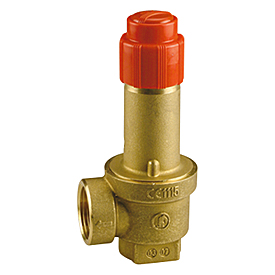R140
CATEGORY: BOILER ROOM PARTS
Safety valve, female-female connections
Description
The Giacomini safety valves of the R140/R140M range are used to avoidoverpressure on the heat generators of the heating system, sanitary water system (protecting the hot water accumulation) and water systems (cold water drainage). The valves comply with Directive 97/23/EC (PED Directive).
Operation
The safety valves are used in hot water thermal systems with a closed expansion tank, to ensure that the pressure of the fluid in the heat generator does not exceed the project limits; when the thrust of the pressurised fluid triggers a return spring on the shutter, the valve discharges a specific amount of fluid to prevent the defined pressure level from being exceeded, and then re-closes within the permitted closure range. They can also be used to drain off cold water in water systems. They are factory-calibrated and the drainage pressure value cannot be altered.
Technical data
• Fluids: hot water, cold water, air
• Temperature range: 5÷110 °C
• Nominal pressure: 10 bar
• Open overpressure 20%
• Closure range 20%
• PED cat.: IV
Materials
• Body in brass UNI EN 12165 CW617N
• Membrane in EPDM
• Separator in IXEF
• Membrane guide ring in IXEF
• Spring in steel
• Spring presser and separator in IXEF
• Knob in polyamide PA66
Installation
Before installing any safety valve, the technical personnel in charge of the system must size it correctly, in accordance with the current regulations. The safety valves must be installed in the highest part of the heat generator, or on the delivery pipe, no more than 1m from the generator. They must be clearly visible and easy to check. The pipe connecting the safety valve to the generator must be free of any interception and with a diameter no less than that of the valve itself. The safety valve drainage must be clearly visible and channelled into a pipe with a diameter no less than that of the valve itself, using a funnel (R141) if necessary.
Maintenance
The valve must be checked at least once a year, by increasing the system pressure to induce drainage. If this is not possible, you can rotate the knob and check the drainage visually. Any impurities that form on the housing can be removed by means of regular purging.
Have a question? Feel free to ask.
Contact us




